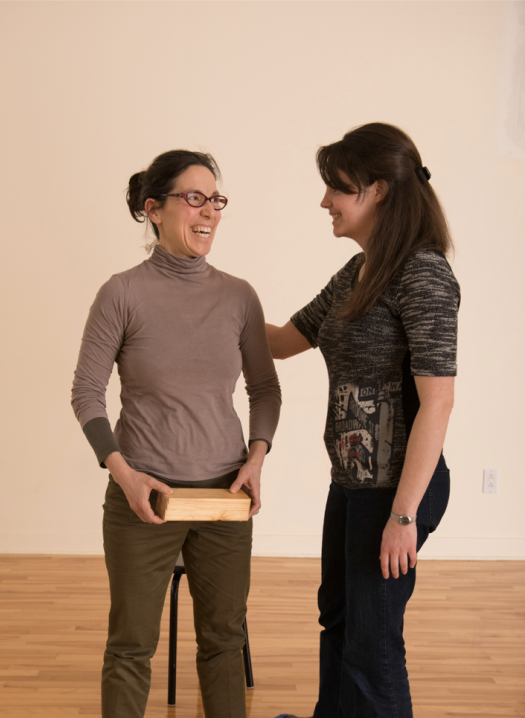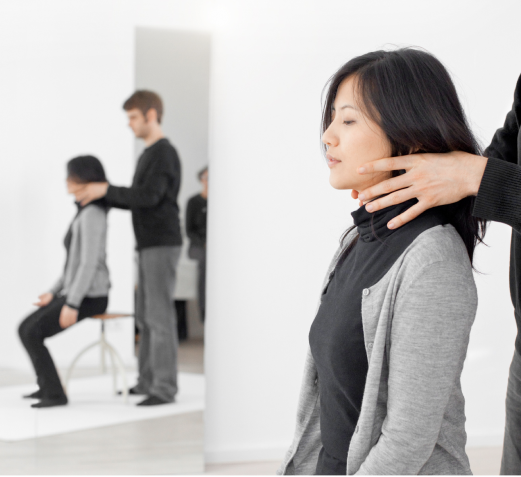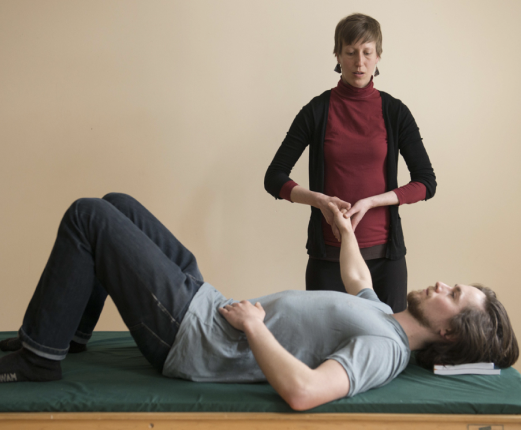Lessons
- Lessons
- Chair Work
- Table Work
- Other Applications
- Testimonials
Lesson Structure
Alexander Technique is usually taught in a series of private lessons typically 30 to 60 minutes in length. Students come to lessons wearing comfortable clothing that does not restrict their movement.
The lessons are taught in a variety of settings, including studios within private homes, health or pain clinics, universities or colleges, and offices.
Alexander Technique is taught to individuals of all ages and interests. Students simply need to have a curiosity to discover, and a willingness to change longstanding unconscious habits that interfere with their well-being.
The lessons are geared to the student’s unique issues and concerns.
Lesson Content
The teacher will use verbal and gentle tactile guidance to encourage students to become aware of patterns of unnecessary muscular tension, with special attention to the relationship of the head, neck, and back, which Alexander teachers refer to as the “primary control.” Students learn through repeated kinaesthetic experiences to reorganize and integrate their bodies, finding a more natural ease of movement and poise.
An Alexander Technique lesson usually produces a feeling of well-being and many students have the experience of feeling “lighter” because they are in a state of expansion instead of their habitual state of contraction.
The teacher will explore the core principles of the Alexander Technique in depth:
- Recognition of Habit
- Recognition of Faulty Sensory Awareness
- Primary Control
- Inhibition and Non-Doing
- Giving Directions
The integrity of the Alexander Technique work is maintained throughout the lesson because teachers must actively engage with these principles at all times. In order to teach students how to do the same, teachers model what they are looking for in the student.
Through these principles, students come to understand how profoundly their thinking can affect their bodies and learn to make lasting positive changes.
Alexander Technique lessons usually, but not always, include “chair” and “table” work (see next pages).
Ready for your first Alexander Technique lesson?
Learn next

When you stop doing the wrong thing, the right thing does itself.
– F. M. Alexander
Chair Work Explained
The term “chair work” was originally coined for the practical reason that a stool was the most widely available equipment available during the earliest Alexander Technique training schools.
Chair work focuses on the dynamic movement of students getting in and out of the chair without using unnecessary muscular tension or compressing their spines during the process. Executed properly, there should be torso and spinal integrity in conjunction with responsive ease of mobility in the hip, knee, and ankle joints.
While getting in and out of a chair should be simple, individuals almost universally will complete the movement with far more muscular tension and effort than should be required. They will typically move their torso forward, tighten their necks by pulling their heads back and down into the spine, and tighten their legs and lower back as they go from sitting to standing and vice-versa. Sometimes people fall back into a seat with momentum, which can be precarious for the elderly.
The teacher assists students to inhibit dysfunctional and habitual tension as they move in and out of the chair. Students become aware that the entire body should be involved in an integrated, fluid movement, with the head leading while the back lengthens and widens.
Chair work is integral to Alexander Technique because it challenges students to see their patterns of misuse in order to prevent them from happening, while creating new directions and pathways for ease of movement.
Ready for your first Alexander Technique lesson?
Learn next

Everyone is always teaching one what to do, leaving us still doing things we shouldn’t do.
– F. M. Alexander
Table Work Explained
During table work students lie on a table in a semi-supine position (on their backs with knees bent). It can be easier for students to notice tension in their bodies and learn how to release it when they are not responsible for any physical movement, as it is the teacher who will move the student’s arms, legs, and head. Table work also allows students to more easily expand their backs.
Table work is often described as “constructive rest” because the teacher engages students’ active participation, building on their attention, awareness and thinking.
In both chair and table work, students usually feel a release of tension and a flow of energy throughout their bodies.
Ready for your first Alexander Technique lesson?
Learn next

We can throw away the habit of a lifetime in a few minutes if we use our brains.
– F. M. Alexander
Other Applications
Everything that is learnt during chair and table work can be applied to any activity.
Depending on the teacher, lessons can also include applying Alexander Technique to various activities, including:
- Playing a musical instrument
- Dancing
- Acting
- Speaking challenges, stuttering and vocal hoarseness
- Breathing
- Computer and desk work
- Prolonged stationary work positions
- Walking
- Running
- Skiing
- Golfing
- Yoga
- Martial arts, etc.
Given that the Technique can be applied to all physical movements of the body, there are truly no limits to the Technique’s application. If you have a particular interest you wish to explore, talk to your Alexander Technique teacher about it.
Distance Learning
Alexander Technique is normally and ideally taught in person with a qualified Alexander Technique teacher who gives both tactile and verbal guidance to the student. All the Alexander Technique teachers listed in the Teacher Directory of this website are certified to teach students in person.
A few Alexander Technique teachers also consult online. This method obviously does not provide tactile instruction and relies only on verbal instruction. Online lessons may be useful when an individual cannot access an Alexander Technique teacher in person, for example, because of pandemic restrictions, geographic challenges, health concerns, etc. However, online experiences are not the same or as beneficial as in-person lessons taught using tactile and verbal instruction.
Ready for your first Alexander Technique lesson?
Learn next

Trying is only emphasizing the thing we know already.
– F. M. Alexander
“The experience of my body being perfectly aligned is a feeling I had never experienced before…no pressure or tension anywhere.”
– Gay Best, Manager
“The Alexander Technique keeps the body alive, at ages when many people have resigned themselves to irreversible decline . . . With all its demands, the Alexander Technique is worth every moment it asks for, and those once committed to it may well find that they cannot do without it. It is an enlargement of whatever life may be yours.”
– Robertson Davies, Author
“Alexander Technique has changed my life and given me the tools to help put control back in my hands to heal. Four years ago, I was in 2 car accidents within 2 months and rear-ended both times. I quickly started trying different therapies like physio, osteopathy, massage and acupuncture in hopes of dealing with the chronic pain and discomfort. Although these treatments helped, they didn’t seem to get to the root of the problem and I wanted a long-term solution. My physiotherapist recommended trying Alexander Technique and I had a series of lessons with my teacher that helped me become more self-aware of my habits and how they contribute to my discomfort. I felt more relaxed and at ease after the treatments and slowly started to feel a level of normalcy again. The thing that impressed me most was that after being rear-ended recently for the 3rd time, I expected more trauma to my body, but found that I was more resilient than ever before and I can only attribute that to the Alexander Technique training. I’m very grateful for the introduction to this way of healing and highly recommend this technique.”
– Kathy Brown, Business Professional

